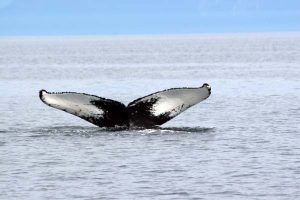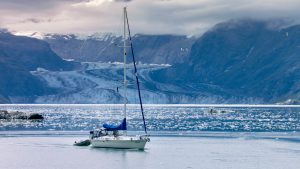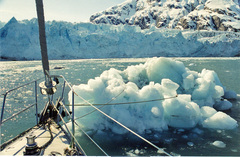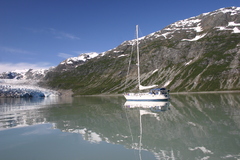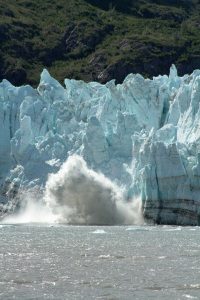 Day 4
Day 4
Today is a long travel day as we continue to explore Glacier Bay. We typically get calm conditions or light northerlies, so we’ll motor for about 6 hours to get to the Marjorie Glacier in Tarr Inlet. As we leave the heavily forested Shag Cove, it seems as if we move back in time with each passing hour. The mature rain forest gives way to a more brushy terrain.
Along the way we make a brief stop along the steep rock faces of Gloomy Knob. There are colonies of kittiwakes nesting along the cliffs, and we also find some puffins and pigeon guillemots swimming in the calm waters at the base of the rocks. Looking with the binoculars, we even see a small herd of mountain goats moving across the seemingly impassably steep rocky face.
We cut inside Russell Island and pass an impressive alluvial flood plain coming out of a valley whose glacier has retreated out of sight. Just as we enter Tarr Inlet we see a brown bear sow with three cubs scavenging along the shore. We drift alongside them for half an hour, watching and listening, our engine off, until the bears gradually disappear into the brush.
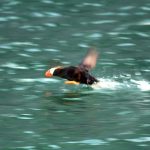 As we continue up the inlet more and more icebergs crowd the water until we have to slow down to an idle in order to work our way through them. We pick our way up to the Marjorie Glacier, cut the engine, and drift along in front of the 200-foot-tall face of the glacier. Craggy spires of blue ice tilt at different angles. The ice constantly pops, cracks, and groans with periodic calving of ice. Each of us makes a guess as to which spire will crash down next, noting where the “small” pieces of ice seem to crumble into the water the most.
As we continue up the inlet more and more icebergs crowd the water until we have to slow down to an idle in order to work our way through them. We pick our way up to the Marjorie Glacier, cut the engine, and drift along in front of the 200-foot-tall face of the glacier. Craggy spires of blue ice tilt at different angles. The ice constantly pops, cracks, and groans with periodic calving of ice. Each of us makes a guess as to which spire will crash down next, noting where the “small” pieces of ice seem to crumble into the water the most.
Eventually several chunks of ice adjacent to one of the huge spires tumble to the water, causing more ice to break away until the grand spire itself teeters and then collapses, thundering into the water. The water erupts with the force of the collision, and sets off a huge swell that radiates out into the arm, rocking our boat in its wake. The sea birds swarm around the gash of ice, now deeper blue where the spire has just jettisoned, as they pursue the freshly exposed invertebrates which the churning water has exposed.
After a few hours of watching the glacier work its magic, we use our landing net to scoop up some cocktail ice (ice that is hundreds of years old) and motor slowly along the shore. Once again we see kittiwakes and puffins nesting along the cliffs as we move past them.
We find a spot to anchor off the mouth of a small stream and enjoy the solitude of ice, water, and majestic mountains surrounding us. We listen to the sound of water tumbling off the steep cliffs, the distant din of the kittiwake colonies, and the occasional cry of a bald eagle as we enjoy the view of the surrounding mountains. At times we can hear the distant thunder of more ice as it crashes down from the glacier’s face a mile away from our anchorage.



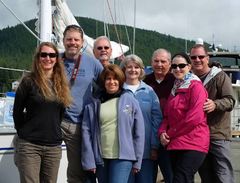 Day 1
Day 1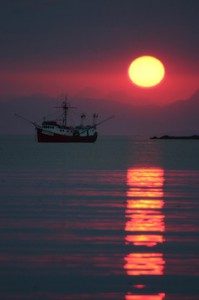
 Day 4
Day 4 As we continue up the inlet more and more icebergs crowd the water until we have to slow down to an idle in order to work our way through them. We pick our way up to the Marjorie Glacier, cut the engine, and drift along in front of the 200-foot-tall face of the glacier. Craggy spires of blue ice tilt at different angles. The ice constantly pops, cracks, and groans with periodic calving of ice. Each of us makes a guess as to which spire will crash down next, noting where the “small” pieces of ice seem to crumble into the water the most.
As we continue up the inlet more and more icebergs crowd the water until we have to slow down to an idle in order to work our way through them. We pick our way up to the Marjorie Glacier, cut the engine, and drift along in front of the 200-foot-tall face of the glacier. Craggy spires of blue ice tilt at different angles. The ice constantly pops, cracks, and groans with periodic calving of ice. Each of us makes a guess as to which spire will crash down next, noting where the “small” pieces of ice seem to crumble into the water the most.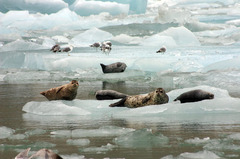 Day 5
Day 5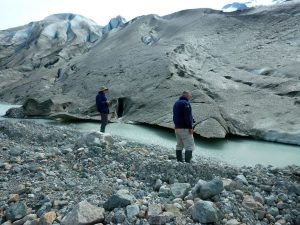
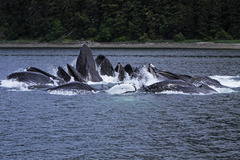 Day 8
Day 8